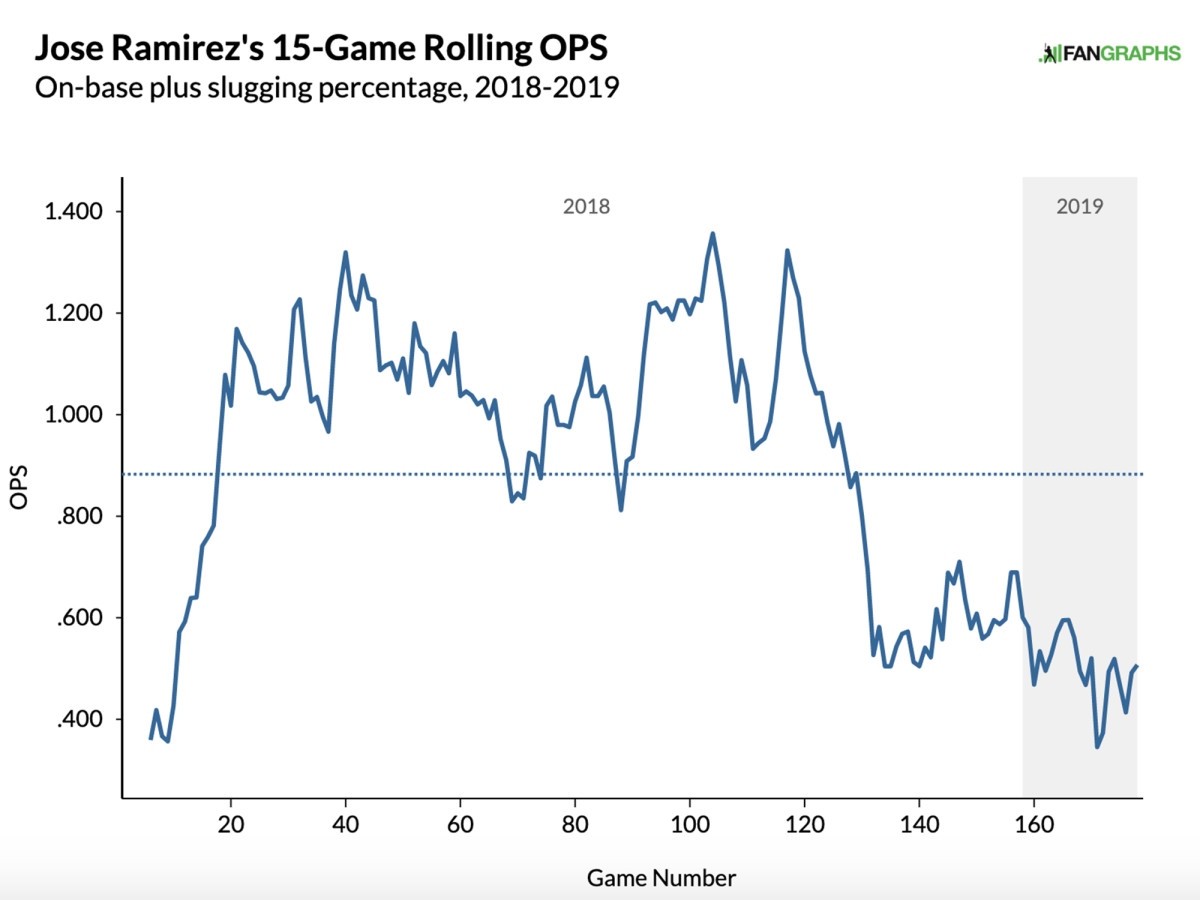What to Make of José Ramírez's Mysterious Struggles

Despite its winning record, Cleveland has had more than its share of problems so far this year. It’s about what you’d expect from an offense that’s had to feature heavy use of names like Max Moroff, Eric Stamets, and 2019 Hanley Ramirez; predictably, it’s been tied for worst in the American League. Meanwhile, a rotation that could have been the best in baseball has seen Mike Clevinger taken by injury, Carlos Carrasco uncharacteristically overcome by struggle, and Corey Kluber really uncharacteristically overcome by struggle. (The relief pitching was never going to be the best in baseball, but, uh…. it truly has not been anything close.)
And there’s been one other problem in here: What is going on with José Ramírez?
Ramírez entered the season as a reasonable favorite for MVP, after back-to-back third-place finishes for the award. He’d followed a strong 2017 (145 OPS+, 29 home runs, 6.9 Baseball-Reference WAR) with a brilliant 2018 (150 OPS+, 39 home runs, 7.9 WAR). This season, however, hasn’t done much to continue this trajectory. Ramírez’s season has begun 13-for-83 (.157)— walking a little less, striking out a little more, with hardly any power—translating to a paltry 24 OPS+. To spell it out clearly, his OPS has been 76 percent worse than the league average. That's a slow start impossible to ignore.
So what’s behind it? And is it as sudden as it seems?
The answer to the second question there might seem self-evident. Of course, this has to be new. Ramírez, after all, is coming off of one of the best seasons by a third baseman in recent memory. (Only 23 other men at the position have ever had a season this good.) Look a little more closely, though, and it’s clear that he was starting to show signs of struggle in the final months of his incredible 2018. Yes, his first half was so hot (180 OPS+) that it might have seemed inevitable for his second half to slip (119 OPS+)—but there was a bit more happening here. In the first half, Ramírez had been hitting the ball harder than ever. Over 40% of his batted-ball contact was classified as hard-hit, per FanGraphs. In the second half, this figure came back down to 28%, right around his career average. Ramírez’s biggest loss here? He wasn’t crushing the zone like he had been. His ISO on in-zone pitches had been .412; it dropped to .274.

Ramírez’s current struggle, then, might logically seem like an extension of this shift last year—perhaps he’s still not hitting the ball as hard, and he’s floundering because of it. But! This isn’t what’s happening. Not at all. In fact, Ramírez is hitting the ball almost exactly as hard as he did in the first half last year. About 40% of his batted-ball contact has, again, been hard-hit. His exit velocity has increased. And lest you suspect that he’s simply been making contact much less frequently, rendering this a misleading conclusion drawn from an especially small sample size—well, it’s April, so most of these sample sizes are small—but his contact rate hasn’t changed significantly this year. It’s down some, from last season’s 88% now to 83%, but he’s still connecting fairly often here, and he’s hitting it hard when he does. (Related: He’s been swinging ever so slightly more, but he hasn’t increased his chase rate, so the dip in contact hasn’t come from more swings at bad pitches.) His hard contact just hasn’t been falling for hits.
If this sounds like simple bad luck… in a way, it might be. Ramírez’s BABIP is .167, among the lowest in baseball, even lower than his .208 from the second half of 2018. It’s not good, but it’s certainly not a death sentence: Jay Bruce, with a 135 OPS+, has an identical .167 BABIP, for instance. Bruce, however, has seen more than a quarter of his flyballs turn into home runs; That hasn’t been the case for Ramírez. BABIP alone is not quite enough to stand out as a singular culprit here, but it’s enough to stand out as something that has not helped.
There’s no one clear offender, in other words. Ramírez’s swing doesn’t look radically different; his approach hasn’t been significantly altered; his stat sheet does not have a definite smoking gun. This is similar to his struggles from last year, but it isn’t the same. This lack of clarity might, weirdly, be seen as encouraging. A slump, sometimes, is just a slump—not a problem in search of a solution, not a hitch in need of a mechanical tweak, simply a phase that is likely to pass. (It’s worth noting that Ramírez had a slow start last year, too.)
Then again, of course, it can just as easily feel discouraging: if nothing in particular is wrong, everything might as well be. But there’s room here for Cleveland to hope otherwise, and for the sake of the team’s competitive hopes, it had better.
